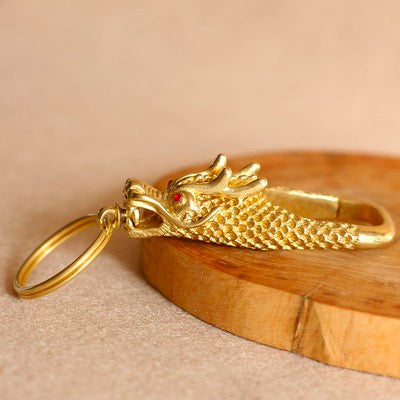From the natural flow of hair to the intricacies of styled hair buns, as ancient Chinese society evolved, their pursuit of innovation extended to the patterns and designs of hair ornaments. People were no longer content with mere practicality; they began to seek artistic value that aligned with their aesthetic aspirations. This led to the infusion of deeper symbolic meanings into the types of hair ornaments and materials used.
The intricate patterns of ancient hair ornaments display a rich and fascinating artistic style, holding substantial artistic value.
I. Evolution of Ancient Chinese Hair Ornament Patterns
- From None to Existence
In the early stages of primitive times, people lacked a systematic understanding of beauty, and thus hairstyles were natural and unadorned. With the advancement of production techniques, hair-styling became a practical necessity, leading to the use of tools made from natural materials such as bamboo or twigs. As the awareness of beauty gradually developed, bone and jade were used to create simple hairpins and combs.
While the concept of beauty was emerging, hair ornaments continued to serve a primarily utilitarian function. Ensuring that hair remained secure and manageable during daily activities was the primary goal. Artistic innovation had not yet become a focal point.
Transitioning to the Neolithic period, archaeological findings reveal that the influence of totem culture led people to adorn themselves with feathers and fresh flowers as hair ornaments, marking the inception of ancient Chinese hair ornament culture.
- From Practicality to Symbolic Status
The development of hair ornaments during the Shang and Zhou dynasties held great significance in Chinese history. It was during this time that gold ornaments began to be widely incorporated into hair accessories.
In comparison to earlier eras, the Shang and Zhou dynasties marked a qualitative leap in hair ornament design. These ornaments not only served practical purposes but also acquired symbolic significance due to the use of precious metals like gold, signifying social status.
- Elaborate and Exquisite Tang Dynasty Hair Ornaments
Moving forward to the prosperous Sui and Tang dynasties, the renowned "diancui" technique of the Qin and Han dynasties merged with the cultural fusion of the Wei-Jin and Northern and Southern dynasties, paving the way for more refined crafting of gold and silver hair ornaments. This period's improved craftsmanship allowed for the creation of more intricate and ornate hair ornament patterns.
The Tang Dynasty, a culturally vibrant era in Chinese history, witnessed remarkable artistic expressions. Women's aesthetic sensibilities flourished, giving rise to diverse hairstyles and a myriad of hair ornaments. Though common types like hairpins, hair combs, and hair clasps remained, their designs became more intricate and innovative. Notably, the prevalent design motifs featured insects, birds, and flowers. These motifs were not only aesthetically pleasing but also emphasized wearability. The asymmetric design of hairpins allowed for secure hair fixation while maintaining aesthetic appeal.
- Return to Simplicity in Ming and Qing Dynasties
The Ming Dynasty witnessed another period of hair ornament development, reaching the pinnacle of ancient Chinese craftsmanship. Ornate welding, inlay, and filigree techniques flourished in this era. The patterns became complex and magnificent.
Hair ornaments of the Qing Dynasty, as often depicted in television dramas, frequently carried auspicious meanings. However, they diverged from the ornate style of the Ming Dynasty.
II. Common Types and Artistic Styles of Hair Ornament Patterns
The pursuit of beauty was a continuous endeavor throughout ancient Chinese history. Hair ornaments played a pivotal role in this endeavor, complementing diverse hairstyles with harmonious and exquisite designs that pleased both the wearer and the observer. The variety of patterns reflected a shared aspiration for a better life.
- Geometric Patterns
Geometric patterns held a unique place among the rich array of ancient Chinese hair ornament designs. Although appearing early in history, these patterns persisted through various dynasties, even if they no longer dominated ornamentation. They remain essential in supplementary decorations.
Geometric patterns, characterized by their simplicity and natural harmony, showcased an early artistic style. These designs originated from basic elements such as straight lines, curves, and zigzags, resulting in various geometric patterns like zigzag, vortex, and valley patterns. While they were prevalent, different dynasties favored different types of geometric patterns, each possessing its own distinct charm.
- Animal Patterns
Animal patterns have been a staple of Chinese hair ornament designs, embodying totem culture's influence and ancient people's attribution of auspicious meanings to animals.
The dragon and phoenix motifs stand out among these animal patterns. The dragon symbolized supreme authority, making it emblematic of imperial power, while the phoenix represented good fortune and love. These motifs held immense cultural and symbolic significance, serving as symbols of both rulership and marital happiness.
- Plant Patterns
Hair ornaments adorned with plant motifs were equally common. Ancient Chinese people held a deep appreciation for nature, believing that the perfect state was achieved through harmony between humans and nature. The "Four Gentlemen" in Chinese painting—plum blossom, orchid, bamboo, and chrysanthemum—inspired headwear designs.
As craftsmanship improved, intricate depictions of flowers and plants flourished. These ornaments conveyed elevated sentiments and ideals while bestowing blessings upon their wearers.
- Human Figure Patterns
The imaginative minds of ancient Chinese laborers extended beyond animals and plants to human figures. Thus, many hair ornament patterns depicted human figures and their stories. These patterns often adorned ceremonial headdresses and were larger in size, allowing for more intricate sculpting and detailing.
Throughout history, these patterns included scholars, youth, and other figures, each holding unique symbolism. Scholars symbolized academic success, while images of young boys represented the aspiration for many descendants. These patterns captured the essence of their respective cultural contexts.
Conclusion:
Over thousands of years of Chinese history, we are born in the modern age, unable to witness these breathtaking moments firsthand. Fortunately, historical records and buried artifacts provide evidence of the past. These relics and accounts allow us to experience the richness of ancient Chinese culture, its diversity of thought, and the inheritance of its traditions.



















